Thai Fruits
Thailand is famous for many things. Thai Fruits is one of them – fruits are an immensely popular export of Thailand (next only to Thai massage !!!)
Mere mention of “Thai fruits” brings to mind images of juicy, colorful and flavourful fruits so completely different from looks and taste of universal fruits (like Apple, orange and banana) that they have become synonymous with something “exotic”. We consume them for their tastes and exotic appeal when our pockets can permit. Some of us are content only eyeing them lustily in the supermarket shelves.
Despite their good availability these days, little is known about them, hence through this blog we will attempt to cover some of the most popular Thai Fruits along with their health benefits.
- Dragon Fruit:

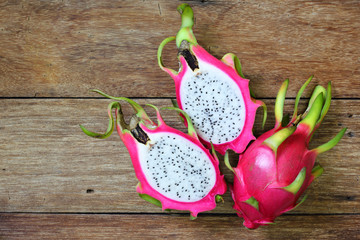
It is a tropical fruit and surprisingly it's a fruit of a cactus plant ! The fruit is really beautiful on the outside and on the inside. Perhaps it is called Dragon fruit as its red colour inside green peels resembles a red flaming mouth of dragon.
Dragon fruit is native to Mexico but due to some clever marketing by Thailand (and Vietnam, Indonesia etc.) it is now associated with south-east Asia and is a major export from there. They are sweet-sour and refreshing, with juicier flesh and a strong taste.
- Uses:
- Eaten as Fresh Fruit
- Slice it or cube it in your museli
- Part of fruit salad
- Part of many tasty drinks and desserts
- juice the fruit (along with other fruits too, if you like, such as kiwi), and transfer it to a mould and freeze it till it’s set), add honey or jaggery to sweeten it – enjoy the sorbet
Dragon fruit is low in calories yet offers numerous nutrients, including vitamin C, B vitamins, phosphorus, protein, calcium, fiber, captin, and antioxidants. Like other red fruits, dragon fruit contains lycopene, which helps protect against cancer and heart disease.
Dragon fruits have a surprising number of phytonutrients. Rich in antioxidants, they contain vitamin C (equivalent to 10 percent of the daily value), polyunsaturated (good) fatty acids, and several B vitamins for carbohydrate metabolism, as well as carotene and protein.
2. Rambutan:
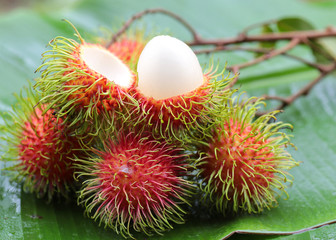
Rambutan is native to Thailand and Indonesian region and close relative of lychee and longan. The word is derived from the Malay-Indonesian languages word for rambut or "hair", a reference to the numerous hairy protuberances of the fruit.
The fruit has smooth, round interior (reminds of the Indian rasgullaa) engulfing a seed much like lychee fruit but the taste is less sweet with a more subtle flavor.Most rambutans are sweet and juicy, but some varieties are acidic or slightly drier.
- Uses:
Fresh Fruit
Fruit Salad
Dried rambutan with seasonings
Rambutan Jam
Smoothies& Juices
In some areas, the seeds are roasted and eaten, similar to roasted nuts.
- Benefits:
The high fiber content of rambutan aids the digestive system in food metabolism, preventing constipation. The fruit also contains high amounts of antioxidants, which makes it both anti-microbial and anti-carcinogenic. Antiseptic Qualities. Claimed to be effective in getting rid of Intestinal Parasites perhaps due to its antifungal properties. Rambutan is a good source of phosphorus, which helps in bone formation and the maintenance of your bones and teeth.
3. Mangosteen:
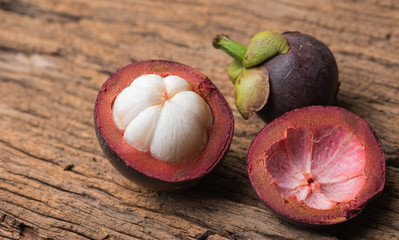
Mangosteen – a very attractive fruit – in fact it looks like a flower more than a fruit- is also knows as Queen of Tropical Fruits. This exotic, round, purple colored fruit is immensely popular for its snow-white, juicy, delicious arils all around the globe. Known as "Mangkhud" in Thai, Thailand is the largest producer and exporter of mangosteens. The flavor of the fruit can be best described as sweet, mildly tangy, fragrant, and delicious.
- Uses
Fresh Fruit
Complements well with a wide range of other fruits in fruit salad
Mangosteen juice is a refreshing thirst-quenching cool drink to fight off the summer effects on body
Eaten with yoghurts
Mangosteen clafouti prepared using cornflour, and coconut milk is a delicious dessert.
- Benefits:
It is moderately low in calories (63 calories per 100 g) and contains no saturated fats or cholesterol which is good news. On the other hand, it is rich in dietary fiber – each piece of fruit will provide about 10% of daily requirement.
Mangosteen is good source of vitamin-C hence helps the body develop resistance to combat flu and help us get rid of free-radicals. Fresh fruit is a mild source of B-complex vitamins such as thiamin, niacin, and folates. These vitamins are acting as cofactors the help body metabolize carbohydrates, protein, and fats.
Further, it also contains good amounts of minerals like copper, manganese, and magnesium. thus, it offers protection against stroke and coronary heart diseases.
4. Longan:
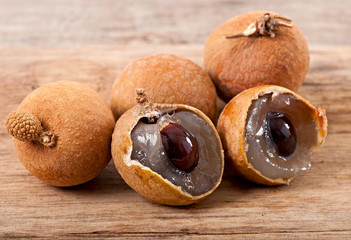
The longan meaning “dragon eyes” is so called because of the fruit resembles eyeball when it is peeled (see picture – the round white smooth ball with the black seed showing through the translucent flesh like the iris of the eye). The seed is small, round and hard like the popular lychee.
- Uses:
The fruit is delicious with a sweet(or sweet and sour – depending on the ripeness level) apart from eating it fresh, it is often used in soups, snacks, desserts, and sweet-and-sour foods, either fresh or dried, sometimes canned with syrup in supermarkets. The seeds of fresh longan can be boiled and eaten too (though rare), with a distinctive nutty flavor. In China, Longan is used less as a food and more as a tonic. Also, it is not uncommon to eat it in dry form.
- Benefits:
Longan fruit contains rich amount of Vitamin C that is equal to 80% of daily requirement. It also contains minerals like iron, phosphorus, magnesium and potassium. It is also rich in Vitamin A and in essential anti-oxidants
5. Passion Fruit:
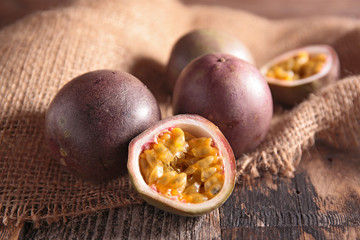
Pleasantly sweet and tart, Passion fruit is also known as granadilla, andis full of health benefits. Passions are native to subtropical wild regions of South America, probably originated in Paraguay but now exported extensively by south east asian countries hence usually forms a part of Thai fruits lists.
There is a religious story of why it is called passion fruit – It is said that the passion fruit was named so by Spanish catholic missionaries four centuries ago in Brazil as “flor passionis” (passion flower) for its purple flower which they believed resembled the five wounds of Christ.
- Uses:
"Granadilla flavoured drinks" are highly popular in Africa and the Middle East
Juice is occasionally obtained by cutting the fruit into two and boiling it.
Hawaiin Fresh Cream made from passion fruit juice, sugar, eggs and butter. When cool, it can be spread on slices of bread, poured onto crepes or used for cakes, doughnuts or parfait.
The yellow variety is generally filtered and then boiled with sugar to produce a thick syrup which is used in a variety of drinks.
Jams combining passion fruit with pineapple and mango are delicious
- Benefits:
First let me demolish the myth that the name of “passion” fruit is due to aphrodisiacal effects – Some people claim that Passion fruit has aphrodisiacal properties but it has not been proved in any scientific studies.Irrespective of any scientific proof, if the belief itself makes it work for you, well, why not ignite some passion !! Eat the fresh fruit and enjoy.
You can also make it a part of fruit salads.
It is reported that the Aztecs used them for their relaxing effects. Perhaps owing to a substance called passiflorine, a natural tranquillizer.
Oil is extracted from the seeds of Passionfruit.
These fruits have found approval from palates of various cuisines and cultures across the globe and made Thailand famous for its produce international. Frugivore bringsto you these pieces of Thailand to your plate at competitive rates and in finest quality. If you are a regular consumer of Thai delights we will be happy to supply you those at further discounts – feel free to contact us (please visit contact us section at the top).
-

6 Best Immune-Boosting Drinks to Fight Off Sickness
It's that time of year when many of us are thinking about what we can do to get through the fall and winter without catching the dreaded cold or flu.…
Mar 19, 2024
-

The #1 Best Fruit for Your Heart, Say Dietitians
Why berries are the #1 fruit to protect your heart.
While all fruit is good fruit, and there are plenty of reasons to enjoy a couple o…
Mar 19, 2022
-

Striking the Balance with Exotics!!!
Have you ever thought how Broccoli is more preferred than Cauliflower nowadays?
Ever given a…Jan 31, 2021
-

Fats - Not Bad!!!
We have always been confused about eating fats, as we think eating fats would lead to weight gain and considered it as the root cause of heart pro…
Jan 19, 2021
-

Know Your Sugar Better!
We came up with this topic because it is the basic step to start the healthy journey which is the new year resolution of most of the people! To un…
Jan 06, 2021
-

Glycemic Index!
Picture an old - fashioned see saw, with plenty of ups and downs. That’s how our blood sugar level goes over the course of day. That all dep…
Dec 28, 2020
-

Not So Sweet!!!
Drinking 12 Oz of regular Coke with 140 calories is a big no when compared with Diet Coke which contains zero calories. Do you know, wha…
Dec 09, 2020
-

Dry Fruits - The Ultimate Powerhouse!
Remember receiving those colourful and decorated boxes packed with different types of wholesome delights? The popular and most loved superfood, kn…
Dec 04, 2020
-

C.H.E.E.S.E - Your Favourite Food
Yummmm!!!! that stretchy mozzarella on pizza and those fragrant pieces of deliciousness and goodness that changes the food into a heavenly treat! …
Nov 25, 2020
-

The Modern Milk Variants
Have you ever wondered, why milk is considered as the most important and healthy drink for the human body? Packed with calcium, p…
Nov 18, 2020
-

The New Age Meat!
Imagine a dinner table which has Bacon Caesar Salad, Chicken Florentine, Prawns in Brandy Sauce, the grand Pork Pepperoni & the epic Bruschett…
Oct 26, 2020
-

Whole Foods - The Way Forward!
The more we get to know about healthy eating and nutrition, the more we think we should eat the way people did a hundred years ago!
We a…
Oct 07, 2020
-

Bravocado Recipes - Part Two!!
So the previous blog was just not enough. Avocado as a superfood is quite versatile. From Pancakes to Ice Creams, from Toasts to Tacos this super …
Sep 28, 2020
-

Bravocado Recipes - Part One!!
Struggling to make your meal delicious with super healthy Avocados? How to make your family change their not-so-healthy lifestyle and get them on …
Sep 19, 2020
-

The Legend of Guacamole
How to make your kids eat healthy or incline them towards health foods in their growing years has always been a challenge. And not only kids, it i…
Sep 12, 2020
-

Fresh Roasted Coffee!
Here's the thing, nothing is more alluring to us than the freshest form of products we consume, and we step onto the same boat when we talk ab…
Sep 07, 2020
-

Covid-19: A few myths busted!
The world came to a halt with the outbreak of SARS-CoV-2 popularly feared by the name of Coronavirus.
The World Health Organisation…
Jun 09, 2020
-

The Quintessential Fresh Story !
The year is 2016. We have brands like Nike, Toyota, Mc Donald’s, American Express, Vodafone, and many more, well established in India, provi…
Feb 05, 2020
-

The Millennial Greens.
All Millennials have completed atleast two decades of their lives. Although, in this social media era, where eyes meet screens more than other eye…
Jan 27, 2020
-

Your Avocado Story !!
Hey there fellow Avocado-lover, we literally feel the same for this superfood. Avocados, now a staple in West have gained immense popularity in In…
Jan 18, 2020
-

New Decade: New Responsibilities !
Greetings from Frugivore for the New Year!
2020 is not only a new year but commencement of a new decade. The difference is that this new…
Jan 14, 2020
-

The Christmas Dinner - Part Two!!
This is with continuation where we left – A room full of happy faces and tummies anticipating on what’s there in the main course and f…
Dec 24, 2019
-

The Christmas Dinner - Part One!
Let’s face it! Festivities are here and so is our ever not satisfied craving to hit that sweet spot for Christmas Dinner. Surrounded by fami…
Dec 23, 2019
-

Bugs in your Greens? Tragedy? – No, it’s a love story!
Picture this - you are preparing for a Sunday salad in your kitchen happily slicing your carrots and chopping the leafies when Mr. Bug creeps in u…
Nov 30, 2019
-

Apple - The one God gave, not Jobs!
The most sold fruit in the whole wide world - Apples are one of the most popular and loved fruit globally. Apples are mostly eaten raw but have va…
Nov 25, 2019
-

Mamma Mia Mushrooms!
For the love of Mushrooms let’s dive in for some amazingly delicious and easy to make recipes. If your kids do not really like Mushrooms, yo…
Nov 12, 2019
-

Blueberry Bonanza !
There’s a fad going on around all the food items involving Blueberry already. Cheesecakes, Muffins, Pies and the list goes on with the…
Nov 08, 2019
-

Vegan's the way!
Going Vegan is not as big as it seems. It’s a matter of choice. Everyone has the right to choose what they want to consume. What has come to…
Oct 18, 2019
-

50 Shades of Avocado ;)
Avocado is a fruit usually grown in equatorial regions; it has a thick rough skin, and a soft gooey pulp. An Avocado has 5 stages of maturity.
…Sep 19, 2019
-

Reasons to Buy Grapefruit Online in Delhi
Grapefruits have shot to popularity with more and more people becoming aware of its amazing health benefits. To enjoy grapefruit, one has to acqui…
Jul 26, 2019
-

Exotic Fruits in Delhi - Stay Healthy and Young
If you are a fruitlover, you can enjoy the goodness of your chosen fruit along with multiple benefits it brings to you. The major benefit of addin…
Jul 26, 2019
-

Best Foods for Your Skin and Hair
Ever heard of the saying you are what you eat? Turns out, Science has proven it Time and again, as Research consistently find healthy food to be g…
Jul 13, 2019
-

Going Green – Why are Green Vegetables Recommended?
Obesity and being overweight are major problems plaguing many of the world’s nations, and this unhealthy weight problem has also been leadin…
Jul 13, 2019
-

Buying Imported Fruits Online ? Read this !!
The fresh-fruit sector of India is now facing changes with the presence of stores selling products and even imported fruits online. And this is al…
Jul 06, 2019
-

Safety & Hygiene
We are delighted to share with all our patrons that Frugivore is ISO:22000 certified and has HACCP (Hazard and Critical Control Points) in place t…
May 17, 2019
-

Avocado Kedavra!
Just like the killing spell of the greatest fictional movie series – ‘Harry Potter’, Avocado is a super effective health fruit w…
May 11, 2019
-

Where do you buy your Fresh ?
Picture this: an elderly lady dressed in expensive silk saree, gold bangles, diamond ring, platinum earings, wearing an exquisite pashmina, gets d…
Jan 14, 2019
-

How fresh are you!
When we commissioned this website recently, the question arose - should we have a blog. And it was decided we should because that’s how we c…
Jan 14, 2019
-

Winter Warm-Up Recipies
Hey folks, its that time of the year again with cold nights and chilly, foggy mornings setting in. Our blogpost today is all about keeping you cos…
Jan 14, 2019











